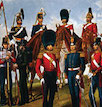A collector in Canada was advised to ask my opinion on this stamp. It is clear from the perforations that this is not genuine.
The genuine £2.42 stamp was issued on 17 March 2020 to pay the airmail rate for letters from 21-100 gr to Zones 1 & 2, ie the world outside Europe.
Sadly there is no postmark on the piece but the smudges suggest that it was on a latter processed by a machine, rather than a packet.
(Image of the forgery has been changed to a sharper one, supplied today.)
The die-cuts appear to be acceptably close to normal (although the right one shows as a dark line on the Queen's back) but
The die-cut 'paper clips' are in fact printed on to the surface - there is no visible cut or indentation to the surface of the stamp. The perforations are of the 'cookie-cutter' type not seen on forgeries of GB stamps for some years and of course lack the elliptical perforation. Each corner is different, not even the diagonally opposite are exactly the same. There is also no evidence of two-bar phosphor tagging.
Also this is the first airmail Machin forgery since the £2.25 in 2018. (There have been forgeries of Christmas and regional airmail-rate stamps.)
Even without the tariff changes which have taken place this year since the spring we would expect these stamps to be in use for only about 12 months, and they are rarely sold outside post office branches, so the principle question is why were they produced? The only plausible suggestion I have had so far comes from a local expert who has an extensive collection of forged Machins, who wrote "it is probably from another bulk worldwide scam maildrop and only used for this purpose".
In other words an organisation trying a scam by mail (fake lottery tickets or some other way to make money from the gullible or unsuspecting) used forged stamps to minimise their outgoings and maximise their income. This was the purpose behind the original £1 MTIL forgery.
UPDATE 2 FEBRUARY: Further information from our correspondent confirms that this was indeed from a money-making scam...
in which the sender (in the UK) claimed that the individual to whom the letter was addressed (in Canada) was the beneficiary of an estate, and could collect the benefit if money to pay fees or expenses was forwarded. Based on the way the letter was addressed, the recipient believes the name and address were likely pulled at random from a telephone directory listing. The envelope and the scam solicitation were discarded.
So if you live outside the UK and have received anything similar, please examine the covers you put aside 'until you can get round to them' and let me know* what you find. Or maybe you have bought some locally-sourced (ie outside the UK) kiloware.
* By email. Ideally a sharp scan of the whole envelope or piece and a close-up of the stamp. Photographs really don't do justice to stamps apart from giving a general idea of a collection.
Anything else I find out will be reported here, and to the relevant specialist societies.






























































